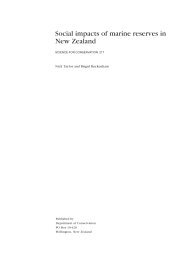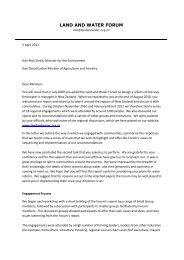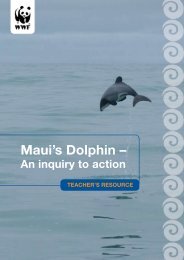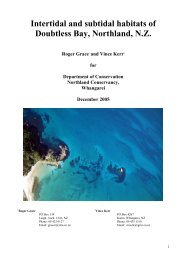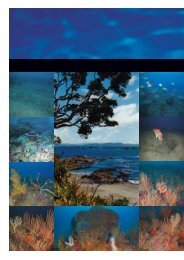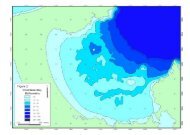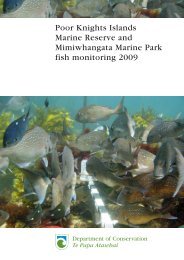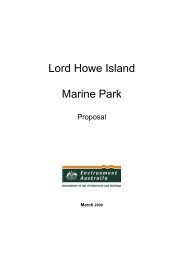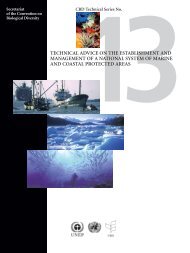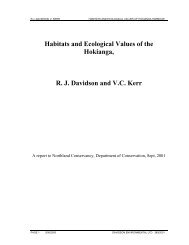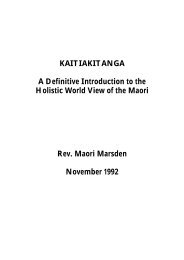WWF Shining a spotlight on the biodiversity of ... - MarineNZ.org.nz
WWF Shining a spotlight on the biodiversity of ... - MarineNZ.org.nz
WWF Shining a spotlight on the biodiversity of ... - MarineNZ.org.nz
You also want an ePaper? Increase the reach of your titles
YUMPU automatically turns print PDFs into web optimized ePapers that Google loves.
Eastern<br />
Stewart Island<br />
Map ID number:<br />
7<br />
Locati<strong>on</strong>: Stewart Island<br />
Approximate area: 2,925km 2<br />
Descripti<strong>on</strong> <strong>of</strong> area:<br />
Deeply indented bays and harbours, exposed<br />
rocky coastlines, and <strong>of</strong>fshore islands. Pristine<br />
inlets and estuaries with large sea grass<br />
(Zostera sp.) and red algal (Lenormandia<br />
chauvini) beds.<br />
Biological attributes:<br />
Eastern Stewart Island has sand-dwelling<br />
fish species such as sand divers (Tewara<br />
cranwellae, Limnichthys spp.), and high<br />
populati<strong>on</strong> densities <strong>of</strong> blue cod (Parapercis<br />
colias), butterfish (Odax pullus), wrasses,<br />
blue moki (Latridopsis ciliaris), trumpeter<br />
(Latris lineata), and sou<strong>the</strong>rn pigfish (C<strong>on</strong>giopodus<br />
leucopaecilus). Estuary headwaters<br />
have abundant galaxiids and smelt (Retropinna<br />
retropinna). Paters<strong>on</strong> Inlet, and possibly<br />
<strong>the</strong> o<strong>the</strong>r large inlets al<strong>on</strong>g <strong>the</strong> eastern<br />
side, appear to be important nursery areas for<br />
trumpeter – large schools <strong>of</strong> juveniles are a<br />
feature <strong>of</strong> rocky reefs inside <strong>the</strong> inlet.<br />
Criteria for inclusi<strong>on</strong>:<br />
Representati<strong>on</strong> (i.e. across physical types);<br />
extremities <strong>of</strong> range and adaptati<strong>on</strong> to envir<strong>on</strong>ment;<br />
habitat complexity/diversity; meet-<br />
Trumpeter, Paters<strong>on</strong> Inlet, Stewart Island<br />
ing ground – overlap between biological<br />
regi<strong>on</strong>s (at nati<strong>on</strong>al and global regi<strong>on</strong>s level).<br />
Status and management:<br />
There is a low level <strong>of</strong> exploitati<strong>on</strong> <strong>on</strong> this<br />
part <strong>of</strong> <strong>the</strong> island, with “pristine” unmodified<br />
catchments at <strong>the</strong> head <strong>of</strong> estuaries. A marine<br />
reserve and a mataitai have been declared in<br />
Paters<strong>on</strong> Inlet.<br />
State <strong>of</strong> informati<strong>on</strong>:<br />
Some fish survey work has been d<strong>on</strong>e in<br />
estuaries and coastal waters.<br />
References and fur<strong>the</strong>r reading:<br />
Francis (1996).<br />
©2004 DOC, Te Papa Atawhai<br />
Estuaries<br />
Map ID number:<br />
8<br />
Locati<strong>on</strong>: Throughout New<br />
Zealand, except for <strong>the</strong> smaller<br />
<strong>of</strong>fshore islands<br />
Approximate area: 79,040km 2<br />
(summati<strong>on</strong> <strong>of</strong> <strong>the</strong> surface<br />
areas <strong>of</strong> all New Zealand<br />
estuaries at high water) 5<br />
Red gurnard<br />
Descripti<strong>on</strong> <strong>of</strong> area:<br />
Estuaries have been classified into eight<br />
categories (e.g. tidal lago<strong>on</strong>, drowned<br />
valley, sound, coastal embayment) based <strong>on</strong><br />
climate, oceanic and riverine c<strong>on</strong>diti<strong>on</strong>s, and<br />
catchment characteristics.<br />
Biological attributes:<br />
Estuaries are critical habitat for<br />
diadromous fishes because <strong>the</strong>y serve as<br />
c<strong>on</strong>duits between freshwater and marine<br />
envir<strong>on</strong>ments. Estuaries are a key habitat for<br />
spawning by diadromous species (species<br />
that migrate between fresh and salt waters).<br />
Some species deposit <strong>the</strong>ir eggs am<strong>on</strong>g<br />
terrestrial plants when spring tides flood this<br />
marginal vegetati<strong>on</strong>. For juveniles <strong>of</strong> many<br />
commercial fish species, such as flounders<br />
(Rhombosolea spp.), mullets (Aldrichetta<br />
forsteri, Mugil cephalus), snapper (Pagrus<br />
auratus), rig (Mustelus lenticulatus), red<br />
gurnard (Chelid<strong>on</strong>ichthys kumu) and o<strong>the</strong>rs,<br />
estuaries are essential nursery habitat. They<br />
©2004 DOC, Te Papa Atawhai/W. Farelli<br />
are <strong>the</strong> sole habitat for a range <strong>of</strong> mainly<br />
small species such as estuarine triplefin<br />
(Grahamina nigripenne) and gobies<br />
(Fav<strong>on</strong>igobius lentiginosus, F. exquisitus),<br />
some <strong>of</strong> which are endemic.<br />
Criteria for inclusi<strong>on</strong>:<br />
Endemism; dependency for o<strong>the</strong>r species;<br />
trophic/functi<strong>on</strong>al diversity; representati<strong>on</strong><br />
(i.e. across physical types); c<strong>on</strong>servati<strong>on</strong> status/threat<br />
classificati<strong>on</strong> both nati<strong>on</strong>ally and<br />
globally; cultural values; extremities <strong>of</strong> range<br />
and adaptati<strong>on</strong> to envir<strong>on</strong>ment; degree <strong>of</strong><br />
disturbance; seas<strong>on</strong>al/migratory importance;<br />
aggregati<strong>on</strong>s; habitat complexity/diversity.<br />
Status and management:<br />
Many estuaries are heavily impacted by<br />
humans, but some that are nearly pristine<br />
include Parengarenga, Whanganui, Catlins,<br />
and several <strong>on</strong> Stewart Island. Catchment<br />
and estuarine development are major threats<br />
to this habitat type.<br />
State <strong>of</strong> informati<strong>on</strong>:<br />
Nor<strong>the</strong>rn North Island estuaries and sou<strong>the</strong>rn<br />
South Island estuaries have been studied in<br />
some detail.<br />
References and fur<strong>the</strong>r reading:<br />
Hartill et al. (2003), Hicks et al. (2004),<br />
Hume et al. (2003), McDowall (1990, 1998),<br />
Morris<strong>on</strong> et al. (2002).<br />
5<br />
Source for estuarine areas: http://fi<strong>nz</strong>.niwa.co.<strong>nz</strong>/<br />
NewZealand/viewer.htm<br />
38 ■ BIODIVERSITY – NEW ZEALAND’S MARINE ECOREGION





